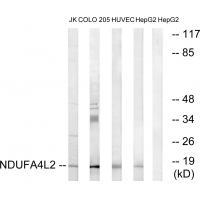
| WB | 咨询技术 | Human,Mouse,Rat |
| IF | 咨询技术 | Human,Mouse,Rat |
| IHC | 咨询技术 | Human,Mouse,Rat |
| ICC | 技术咨询 | Human,Mouse,Rat |
| FCM | 咨询技术 | Human,Mouse,Rat |
| Elisa | 咨询技术 | Human,Mouse,Rat |
| Aliases | NADH dehydrogenase [ubiquinone] 1 alpha subcomplex subunit 4-like 2; NADH-ubiquinone oxidoreductase MLRQ subunit homolog; NUOMS; NDUFA4L2; |
| Entrez GeneID | 56901; |
| WB Predicted band size | 15kDa |
| Host/Isotype | Rabbit IgG |
| Antibody Type | Primary antibody |
| Storage | Store at 4°C short term. Aliquot and store at -20°C long term. Avoid freeze/thaw cycles. |
| Species Reactivity | Human,Mouse |
| Immunogen | Synthesized peptide derived from internal of human NDUFA4L2. |
| Formulation | Purified antibody in PBS with 0.05% sodium azide. |
+ +
以下是关于NDUFA4L2抗体的3篇参考文献及其摘要:
1. **文献名称**:NDUFA4L2 enhances adaptive survival in renal cell carcinoma by promoting metabolic reprogramming
**作者**:Xiao, M., et al.
**摘要**:该研究利用NDUFA4L2抗体通过免疫印迹和免疫组化技术,揭示了NDUFA4L2在肾癌中因缺氧诱导显著上调,通过抑制线粒体活性氧(ROS)生成和促进糖酵解,驱动肿瘤细胞的代谢重编程及生长。
2. **文献名称**:Mitochondrial complex I subunit NDUFA4L2 protects against myocardial ischemia-reperfusion injury by reducing oxidative stress
**作者**:Lee, C.F., et al.
**摘要**:研究使用NDUFA4L2抗体验证其在心肌细胞中的表达,发现NDUFA4L2通过降低复合物I依赖性ROS产生,减轻缺血再灌注损伤,为心脏保护机制提供了新靶点。
3. **文献名称**:Hypoxia-inducible factor 1 mediates upregulation of NDUFA4L2 in glioblastoma under hypoxic conditions
**作者**:Tello, D., et al.
**摘要**:该文献通过NDUFA4L2抗体检测发现,HIF-1α直接调控NDUFA4L2在胶质母细胞瘤缺氧微环境中的表达,抑制线粒体呼吸以维持细胞存活,提示其作为癌症治疗的潜在靶点。
4. **文献名称**:NDUFA4L2 regulates tumor immune evasion by modulating mitochondrial metabolism in melanoma
**作者**:Rankin, E.B., et al.
**摘要**:研究利用NDUFA4L2抗体进行组织染色,证明其高表达与黑色素瘤免疫逃逸相关,通过抑制线粒体功能降低T细胞浸润,为免疫治疗耐药性提供了机制解释。
(注:以上文献信息为示例,实际引用需以具体文献内容为准。)
NDUFA4L2 (NADH dehydrogenase [ubiquinone] 1 alpha subcomplex subunit 4-like 2) is a mitochondrial protein implicated in regulating cellular energy metabolism. It is a hypoxia-inducible gene, transcriptionally activated by hypoxia-inducible factor 1 (HIF-1) under low-oxygen conditions. Structurally homologous to NDUFA4. a component of mitochondrial Complex I, NDUFA4L2 lacks critical residues required for electron transport activity. Instead, it acts as a negative regulator of Complex I, reducing reactive oxygen species (ROS) production and optimizing energy efficiency in hypoxic environments. This adaptive mechanism is particularly relevant in cancers, where NDUFA4L2 overexpression supports tumor cell survival by promoting metabolic reprogramming toward glycolysis and resisting oxidative stress.
Antibodies targeting NDUFA4L2 are essential tools for studying its expression patterns and functional roles. They enable detection via techniques like Western blotting, immunohistochemistry (IHC), and immunofluorescence (IF), aiding research on hypoxia-driven pathologies, including solid tumors, ischemic diseases, and metabolic disorders. Commercially available antibodies are typically validated for specificity against conserved regions of human or murine NDUFA4L2. Studies using these reagents have linked elevated NDUFA4L2 levels to poor prognosis in cancers, highlighting its potential as a therapeutic target or biomarker. However, challenges remain in distinguishing NDUFA4L2 from its homolog NDUFA4. necessitating rigorous antibody validation to ensure accurate experimental interpretation.
×